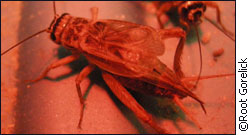
|
|
Close your eyes in the Root Gorelick lab of the H.H.J. Nesbitt Biology Building, and you’d swear you were sitting in your backyard on a warm summer’s night as the unmistakeable sound of chirping crickets takes over your senses.
Behind a long, black curtain at the back of the lab, dozens of numbered containers housing over 250 crickets reveals the source of the chirping. Assistant Professor of Biology Dr. Susan Bertram and her research team are eavesdropping on the sounds made by these singing insects, recording and analyzing their mating songs and signalling. They hope this will solve a great evolutionary biology mystery: What hereditary traits are so successful that they continue to be passed on and maintained over time? In theory, hereditary traits that increase fitness should multiply until they no longer vary in a population. “This is not what we’re seeing,” says Bertram. “The amount of genetic heritable variation in populations has stayed high. From an evolutionary biologist’s perspective, I believe it’s fundamentally important to know why this happens.” New technology paves the way To try to uncover the heritability of traits that equals success and survival in crickets, Bertram has been studying their mating and reproductive behaviour through listening to their chirping, their mating call. “The acoustic research facility that we have now has allowed us to determine that female crickets are attracted to male crickets that produce loud and long calls,” says Bertram. “We don’t know, however, what makes a sexy male. Is it food quality? Is it a good gene? What is it that allows a male cricket to sing in a very attractive way?”
In order to collect this information and perform large-scale selection experiments, Bertram needed to monitor multiple crickets at a time. In July 2007 Bertram was awarded a grant of $250,000 from the Canada Foundation for Innovation, the Ontario Government and Carleton University to establish a new state-of-the-art Behavioural Acoustic Research Facility. This facility will be located in a renovated greenhouse in the Nesbitt Building and encompass high-scale computer monitoring systems that will increase the quality and speed at which the calls are captured and analyzed. The new acoustic recording device will produce a terabyte of data a day — 1,000 GB. “This level of data collection would have been unheard of two years ago because we just didn’t have the technology to collect data on so many crickets simultaneously,” says Bertram. “Each cricket will be stationed to a microphone which will record them and their acoustic signalling for hours at a time and input the data into a comprehensible computer system.” Practical pest management The facility will also help Bertram’s research team develop innovative control methods for acoustically signalling crop pests. When a male cricket signals to attract a female cricket, its attractive call may also attract a parasitic fly, such as the parasitoid Tachinid fly, which kills its hosts to lay eggs, according to Bertram’s research.
“A potential biological control method to reduce the number of crop pests would be to release a bunch of these Tachinid flies,” says Bertram According to a Statistics Canada survey on farm environmental management conducted in 2002, approximately seventy-five percent of Canadian farmers reported using pesticides to control pests. Pesticides help farmers obtain better crop production, which makes for more profitable farming and cheaper food. However, the negative risks on health and environment have become the topic of fierce debate in farming communities and corporate boardrooms, according to Sherri Doherty from Statistics Canada. Bertram hopes her research will lead to effective biological control methods of crop pests in order to reduce pesticide use in Canada. Consequences for Canadian farmers and the agricultural industry Lily Visanuvimol, a Carleton University graduate student working with Bertram, is also looking at innovative control methods for acoustically signalling crop pests. “Canada’s agricultural industry is constantly plagued by crop pests,” says Visanuvimol. “About six years ago there was a huge pest infestation that wiped out many Canadian crops, costing millions of dollars. Understanding how human-induced changes in the environment influence insect growth-rate, reproduction, and survival could profoundly impact Canada’s economy.”
Phosphorus and nitrogen are continually being added to the environment in the form of pesticides, and fertilizers, according to Visanuvimol. Her preliminary research has shown that crickets which are fed high amounts of phosphorus showed a larger body size and reproduced more frequently. “This research could have serious consequences for farmers and the agricultural industry because while they may be adding high amounts of phosphorus to enhance their crop production, they may also unknowingly be enhancing the pest population,” says Visanuvimol. She hopes that her research will lead the Canadian agricultural industry to seek out alternative fertilizers that only enhance crop production and not the pest population. cricket song and cricket size may well be the key to finding practial and environmentally sound methods to limit pest populations. “By understanding the mating habits of these pests, we may be able to control their reproduction,” Bertram says.
|
|
|


